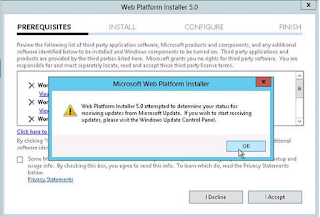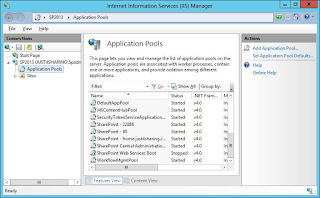Microsoft Workflow Manager Installation Guide
You can install Workflow Manager on
the SharePoint Server itself or you can have separate environment for Workflow
Manager and attach your SharePoint 2013 farm to the Workflow Manager farm
Prerequisites for Workflow
Manager
If you want to install Workflow Manager 1.0, here are
the pre-requisites:
.NET Framework 4 Platform
Update 3 or .NET Framework 4.5
Service Bus 1.0
Workflow Client 1.0
PowerShell 3.0
The following are the pre-requisites to configure
Workflow Manager 1.0
Instance
of SQL Server 2008 R2 SP1, SQL Server Express 2008 R2 SP1, or SQL Server 2012.
TCP/IP connections or named pipes must be configured in SQL Server. Windows
Firewall must be enabled. [Windows Firewall is Off on target server] Ports
12290 and 12291 must be available.
Installation steps
To install Workflow Manager, we need to first install
Windows Platform Installer 5.0 x64 bit.
2. Run Windows Platform Installer.
3. Select “I accept the terms in the License Agreement”
checkbox and click OK.

4.
It’ll take some time to install Windows Platform
Installer.

5.
Once WEB PLATFORM INSTALLER is installed, go to start
and search for “Web Platform Installer”, and then click on the “Web Platform
Installer” icon.

6.
The application will load all the required files.

7.
Once done, you
would get this screen as shown in the image below.

8.
In this screen, go to the “Products” tab.

9.
Click on "Add" button for the below
products.
1.
Workflow Manager 1.0
2.
Service Bus 1.o
3.
Workflow Client 1.0
4.
Workflow Manager 1.0 Refresh (CU2)
10.
Now, click on
Install.

11.
Click on “I Accept”.

12.
You may see a prompt as shown below; don’t worry and
just click OK.

13.
Now, the WEB PLATFORM INSTALLER will start the
installation process and may take some time to install the selected products.

14.
After the installation of the selected products the
wizard will tell you that some of the products require some additional
configuration. Click on the: "Continue” button as shown in the image
below.

Alright, so now we’re
done with installing the workflow manager, let’s look at how to configure it.
Configuring Workflow
Manager
1. Open Workflow manager
and select “Configure Workflow Manager Farm using Custom Settings” option as
shown in the image below.

For Farm Management
Database, provide the SQL instance name and the database name. Click on “Test
Connection” button. It will take some time to verify and show the green tick
mark symbol once the connection is verified as shown in the image below.

3. Follow the same steps
for “Instance Management Database” and “Resource Management Database”.
Provide the service
account and password which you want to use for Workflow manager configuration.
Note
Please bear in mind that
you need to use a separate service account for Workflow manager configuration
and not the same farm account. Else, you will get errors during the
configuration.

Also, please note that
this account should be part of the local administrator’s group on server(s)
where you are going to configure Workflow Manager and should also have
“Sysadmin” permissions on the SQL Instance.
Next, you need to provide
Certificate generation key. This is same as the “Passphrase” which we create
while configuring SharePoint server farm. For adding new Workflow Host or
Service Bus Host, you will need to provide the same key.

After setting certificate
generation key, we need to configure ports for communication between workflow
farm and SharePoint farm. Below are the ports we need to configure:
Workflow Manager
Management Port for HTTPS – Default port is 12290 for HTTPS.
Workflow Manager
Management Port for HTTP – Default port is 12291 for HTTP. If you want to use
HTTP protocol for using Workflow management service, we need to select the
checkbox “Allow Workflow management over HTTP on this computer”.

To open the ports, we
need to create appropriate inbound rules in firewall. This wizard provides an
option to create the firewall rules automatically. Select the check box to
create firewall rules.

At this point, specify
admin group for Workflow Management farm. This means we need to specify the
domain or local group whose members should be treated as administrators. By
default, “BUILTIN\Administrators:” group is added as administrator group for
the Workflow farm.

9. Click Next [right
arrow] at bottom of the dialog box. It will take some time to validate the
configuration settings and save the same.

10. Now, it’s time to
provide required details such as database info, service account and certificate
generation key for Service Bus Farm.


If you want to use the
same service account which you provided for Workflow Manager Farm in the
previous window, you can select the check box “Use the same service account
credentials as provided for Workflow Manager”.
For certificate
generation, select the select the check box “Auto generate”.
If you want to use the
same certificate generation key which you provide for Workflow Management Farm
in the previous window, you can select the check box “Use the same certificate
generation key as provided for Workflow Manager”.
14.

 Configure required ports for communication.
Configure required ports for communication.
14. Enable firewall rules
and provide Admin group.

 After providing all the information, click on next
step. Wizard will show you summary of the configuration you have provided. At
this point, review the settings and if you want to change something, go back
and make the required changes and then come back to summary page.
After providing all the information, click on next
step. Wizard will show you summary of the configuration you have provided. At
this point, review the settings and if you want to change something, go back
and make the required changes and then come back to summary page.
16. Now start configuring
the farm.

It will take around 10
minutes to configure the Workflow Manager and Service Bus farm.
Once the processing
completes, close the window.
Step 16: Check
Application Pool “WorkflowMgmtPool” running or not

Step 17: Check web site
“Workflow Management Site” running or not

Step 18: Install
 Step 19: Install Workflow Manager 1.0 Cumulative
Update 1
Step 19: Install Workflow Manager 1.0 Cumulative
Update 1
Step 20: Do IIS RESET
Step 21: Workflow Service
Status will remain “Not Connected” (http://<>/_
admin/WorkflowServiceStatus.aspx)

Step 22: You need to
register “Workflow Manger”. For that, Open Management Shell

Step 23: Give this
command “Register-SPWorkflowService -SPSite “http://xxxx”
-WorkflowHostUri “http://xxxx:12291” – AllowOAuthHttp

Step 24: Refresh the page. Your Workflow Service Status is “connected”
now.

Step 25: You can also verify this using SharePoint Designer. For that,
connect to the server

Step 26: Select Workflow, click on
List workflow. Check the platform type by clicking on Platform Type Selection
box. You will see both SharePoint 2010 Workflow and SharePoint 2013 Workflow.

Troubleshooting
For security reasons, the Setup account cannot be
used to create a workflow based on the SharePoint 2013 Workflow platform. If
you try to create a workflow based on the SharePoint 2013 Workflow platform by
using SharePoint Designer 2013, you receive a warning that the list of workflow
actions does not exist, and the workflow is not created.
The user who deploys and runs a workflow must be
added to the User Profile service. Check the User Profile service application
page in Central Administration to confirm that the user you are using to
validate workflow installation is in the User Profile service.
You can determine which ports SharePoint Server and Workflow Manager
are using for both HTTP and HTTPS by using IIS Manager as shown in the figure.
Figure: Use IIS Manager to
view the ports used by Workflow Manager

View ports in IIS Manager.
Workflow Manager communicates by using TCP/IP or
Named Pipes. Make sure that the appropriate communication protocol is enabled
on the SQL Server instance that hosts the Workflow Manager databases.
The SQL Browser Service must be running on the SQL Server instance
that hosts the Workflow Manager databases.
Note
When you install Workflow Manager on a server it
automatically installs the Workflow Manager Client on that server. You will
still have to install the Workflow Manager Client on any additional servers.
For example, if you have a farm that contains five servers and you install
Workflow Manager on one of those servers you will still need to install the
Workflow Manager Client on the four additional servers.









































No comments:
Post a Comment